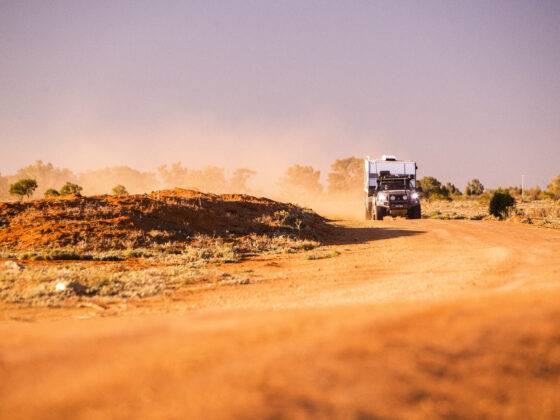In my role as a reviewer of camper trailers and caravans I get to see a lot of great camping equipment. As a 4WD tourer I’ve travelled much of the country and seen what survives harsh conditions and what doesn’t. So, when it came to laying my own hard-earned cash, what did I buy? Why, a Kelly Campers of course!
Last winter, my daughter and I were travelling in the Strzelecki when we came across the remains of one family’s holiday dreams spread across the desert. This was the aftermath of the trailer axle shearing off and the camper trailer spreading its load over about 50 metres of the roadside. The tent was on one side, the trailer on the other, and the rest of the kit in between.
Suspension
At the time of seeing the broken trailer, I was in the process of deciding what camper I should buy. I definitely needed a trailer that could handle long days of corrugations without the trailer or the eggs breaking. Independent suspension seemed to come out on top of my investigations.
Once I’d decided on the type of suspension, which suspension company would I trust to support my holiday dreams? I wanted Australian-designed suspension that had been vigorously tested in Australian conditions. The company that seemed to fit the bill was Vehicle Components (VC); and spares would be readily accessible should I ever need them.
After watching videos of VC testing its gear, the XT independent suspension was the solution I’d look for. I knew a couple of trailers that used this as their choice and I’d had the opportunity to tow them for reviews – so I knew how they felt behind the FJ. They had towed well across a variety of terrain. Done. Suspension sorted.
Trailer
This decision required that the trailer had to be Australian-made, which meant that it wasn’t going to be the cheapest camper on the market. There are a number of great Australian-made campers out there… so I still had some good options to choose from.
The profile of the trailer was important to me. I was concerned that the higher the trailer (particularly if it had a heavy rooftop tent on it), the higher the chance of a rollover in the bush. It has happened in the real world.
The length of the trailer should not be too long either… around 4.0m or less if possible. Tare weight had to be less than 1,000kg but I wanted to carry a good load. I narrowed it down to three trailers from different companies that could suit my requirements.
Kitchen
Needs to be easy to access whether on the road or camped. Ergonomic design so I’m able to reach stove, sink, pantry, food preparation and fridge all in the same area without moving to other parts of the trailer. For example, no need to access the fridge at the back or front of the trailer when the stove and food preparation is on the side.
Awning
This may seem like an odd item to give a high level of importance to… except actually in camp when you are probably either asleep or under the awning. The awning needs to cover the kitchen; and needs to be able to cope with heavy rain and high wind loads. And I wanted to be able to be out of the rain without setting up walls. To achieve these requirements, the awning would need to have a large roof area. Ideally it would need to have square ends and have 270-degree coverage. There were a couple of awnings that could do this. It also needed to be able to be set up and pulled down by one person.
The awning that seemed to achieve all of the above (and have a reputation for quality) was the Supapeg awning. The model I was after had poles that are connected to the spreaders so they will drop down as the awning is deployed. This eliminates the need for ropes in all but the highest of wind loads.
Accommodation
A soft-floor tent was not an option as I had used one of those for a number of years and did not like the amount of time needed to set up and pull down. This meant that a rooftop tent of some description looked to be the best option.
These days there are plenty of selections to choose from in the rooftop arena. Whichever one it was going to be, it needed to have a roof over the entry so that no rain would get into the sleeping area in wet weather. This reduced the choices… but there were still both hard-shell and canvas options.
Again, it needed to be quick to deploy and pack up. I came upon an excellent canvas rooftop tent from Crazy Dog Canvas that ticked all the boxes and more. It is like a second awning as well.
Power
In terms of power, I am a hungry power user with many different device batteries to keep full so that drones, computers, tablets and cameras are all ready to go. I needed enough power to supply all these and the fridge for four or five days without moving and without taking a generator. A lithium battery system from Enerdrive would suit my needs.
The Decision
Three camper trailer options were reduced to two. It was time to look over my decision points and requirements again.
The one camper trailer that could deliver everything and suited my particular needs was the Kelly Camper XC-1. I put down my hard-earned cash and have now towed it for around 3,000km on beaches, up rocky steps and through muddy mountain tracks. It has survived thunderstorms, high winds and dusty trails with distinction.
An Australian-made camper trailer with Australian-made components. Great quality that I can take to the ends of Australia and back again.
And it comes in yellow!
To have a look at the Kelly Campers range, and for more information, see: http://www.kellycampers.com.au
















